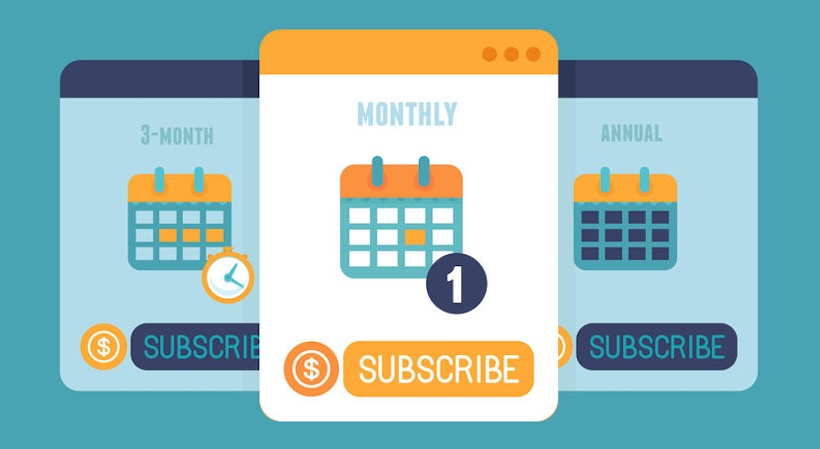
With customer acquisition costs rising steadily over the past six years, multi-channel retailers across all sectors are turning to subscription-based models to achieve longer-term engagement with their customers.
From streaming services (e.g. Netflix), to software (e.g. Office 365), to consumables (e.g. Birchbox and Laithwaite’s Wine), 65 per cent of UK households today are signed up to a regular subscription service. The industry is currently worth around £323 million per year in the UK and is only set to rise.
Interestingly, the global market for physical subscriptions is set to surpass digital subscriptions in 2022. So, looking at product-based solutions in particular, how can retailers build an effective subscription model that not only attracts new customers, but keeps them coming back for more?
Step 1 – adopt a problem-solution approach
Before you launch a subscription business, you need to identify a real-life problem that your target audience is trying to solve. For instance, a premium pet food subscription company we work with identified that their customers are looking to give their pets the highest-quality food, according to their size and weight. It goes without saying that they need to replenish food regularly, and that they are unlikely to want to carry heavy crates to their door each time. The pet food brand solves all these problems for this audience with one tailored subscription package.
Another example of a successful subscription offering is a skincare range that is marketed as a continual maintenance regime for those who suffer from ongoing skin complaints. Meanwhile, food subscription boxes, such as HelloFresh, solve the convenience problem for customers who are struggling to find the inspiration (not to mention ingredients) to prepare quick yet interesting meals.
Step 2 – focus on product quality and customer experience
Once you’ve identified the problem-solution based proposition, it’s time to focus on product and purchase experience. In order to maintain regular purchase behaviour, the product and purchase experience needs to be exceptional, seamless and well thought through. If you’re offering a poor-quality product, not only will you lose repeat orders but the negative online reviews will soon impact your customer acquisition. The subscription proposition needs to be clearly conveyed and the delivery experience needs to be convenient for the customer, especially when taking receipt of larger parcels.
The early customer experience is critical to success and must be exceptional, from premium products and packaging, to a helpful call centre, to a user-friendly website. If not, you run the risk of the customer cancelling after the first shipment.
Step 3 – keep up the momentum
Retaining a customer after the recruitment delivery is a huge milestone for a subscription-based business, but the journey doesn’t end there. Just as you’ve focussed on the initial experience, you also need to focus on the continued experience, to keep customers on that cycle of purchase for as long as possible. Not only do they need to be continually engaged with your brand, they need to see the continued value of the product(s) you are offering.
The key to building an incentivised journey is through timely and relevant communication. How you communicate will depend on several factors including the type of product, the price point, the frequency of deliveries, and the point of likely drop-off in the subscription cycle.
For customers on a lower-value, more frequent cycle such as a weekly snack box, earning a free gift or free shipment after several deliveries can be a good strategy to maintain purchase behaviour. For higher-value and less frequent deliveries, reiterating value, quality and exclusivity in your messaging is important, alongside a customer service programme focused on “saving” customers when they consider cancelling.
Step 4 – test and measure performance
No matter how many subscription tiers you offer, it’s important to continually assess which solutions are working well and which should be adapted, or even discontinued. Through data analysis, you can determine your most valuable customers across each tier, which will then allow you to adapt your recruitment strategy to bring in more of those types of customers.
When monitoring the performance of your subscription scheme, there are three key metrics to focus on: cost per acquisition in context of the forecast lifetime value of your customers, conversion to second purchase, and key performance metrics associated with each post-recruitment shipment i.e. shipment rate, cancellations, returns, refunds, refund/cancellation reasons, and refund/cancellation timings. Building a clear understanding of performance will allow you to build a meaningful test plan focused on influencing elements of customer behaviour which will have the biggest impact on your business performance.
Step 5 – be agile
Be prepared to ask your customers the right questions if they are on the brink of cancelling. For example, is there too much product? Is it too frequent? Is it too expensive? Where feasible, be prepared to offer them an alternative tailored to their needs. If you’re receiving consistent negative feedback on a product or service, then it’s important to address the issues and modify your offering to avoid longer-term impact.
By Claire Odom, Director of Client Strategy, The Tapestry Agency
As subscription models continue to gain popularity, it can be easy to jump on the bandwagon without proper consideration. Focusing on the proposition, product, customer experience and a robust test-and-measure strategy will provide a framework for a successful subscription launch plan.








Share